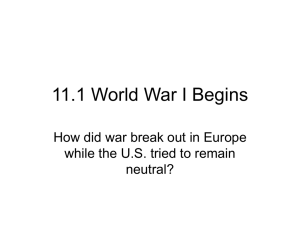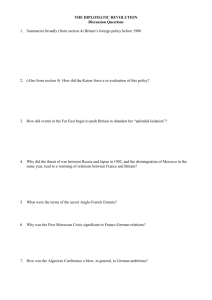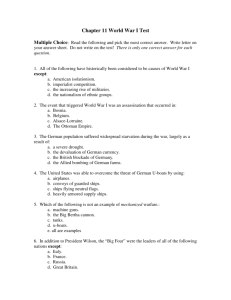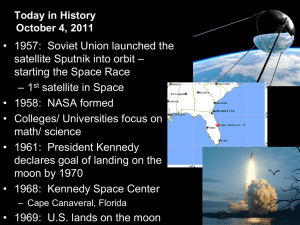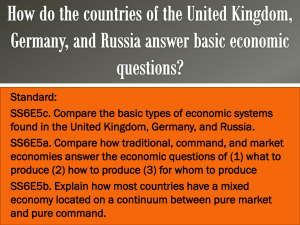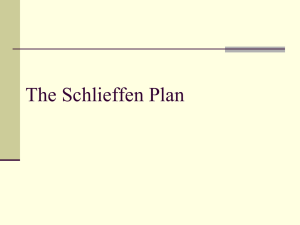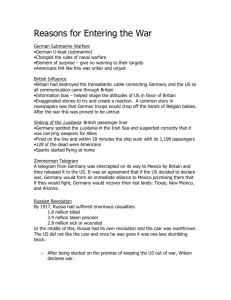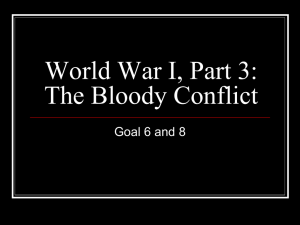CHAPTER 18 THE FIRST WORLD WAR CH. 18
advertisement
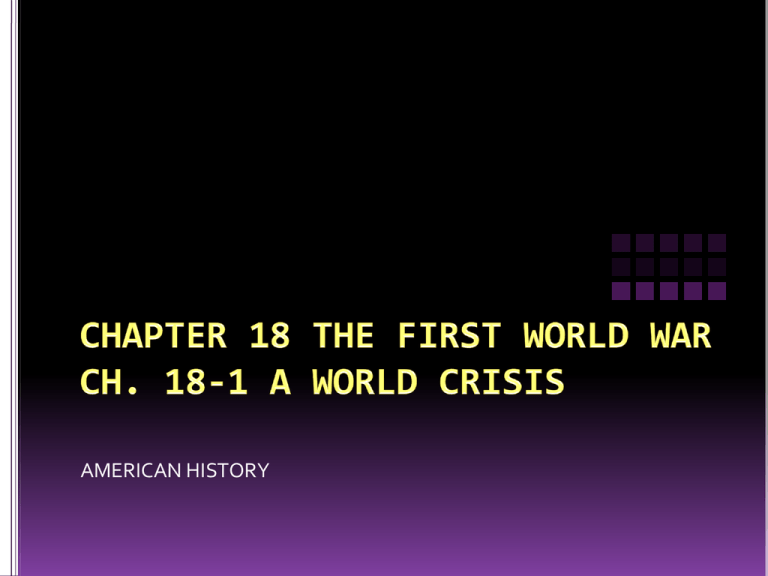
AMERICAN HISTORY June 28, 1914--The assassination of the Austro-Hungarian Archduke Francis Ferdinand and his wife by 19-year Serbian Gavrilo Princip Most of Europe would be at war within 5 weeks How could 1 assassination start a world war? A series of political changes in Europe made war almost unavoidable 1) NATIONALISM Extreme pride or devotion to their country Nationalism led to the formation of new countries such as Germany and Italy in the 1870s It also led to competition for power This struggle was most visible in the Balkans—a region of southwestern Europe made up of many ethnic groups The current rulers, the Ottoman Empire, started falling apart in the 1800s The Austro-Hungarian Empire saw an opportunity to expand—annexing Bosnia and Herzegovina Many slavic peoples, such as the Serbs, rejected the rule of outsiders Russia saw itself as a protector of the Serbs By the early 1900s, tensions were high 2) IMPERIALISM Late 1800s—Great Britain and France had colonial empires in Africa, the Middle East, and Asia Colonies provided markets and natural resources Kaiser Wilhelm II (Germany) wanted colonies, too Germany would need a stronger military 3) MILITARISM The policy of military preparedness and building up weapons 1900—Germany began to build a navy that could take on the world’s strongest navy of Great Britain Germany also enlarged its army and provided them with the latest weapons—machine guns and larger artillery Germany army officials began drawing up war strategies The Schlieffen Plan—precise instructions for waging a two-front war against France and Russia at the same time It also called for a surprise invasion of France by passing through Belgium and subsequent attack on Russia Great Britain, France, and Russia worry about Germany’s intentions These countries start to build up military in case war breaks out European countries believed that strong militaries would prevent countries from attacking each other 3) ALLIANCES Countries formed alliances to maintain peace but they led directly to war Two Alliances: 1) Triple Alliance—Germany, Austria-Hungary, Italy 2) Triple Entente—Great Britain, France, Russia Some Europeans believed these alliances would create a balance of power and decrease the chance of war After the assassination, Princip was arrested An investigation revealed the Serbia had provided them with guns and bombs Austria-Hungary blamed Serbia for Ferdinand’s murder and declared war Russia promised to protect Serbian Slavs Russian army quickly mobilizes Germany views Russia’s mobilization as an act of aggression against Austria-Hungary Germany declared war on Russia and France THE GERMANS TAKE BELGIUM August 14, 1914—German troops cross into neutral Belgium Great Britain pledged to help Belgium so they declared war on Germany Most countries had chosen sides: 1) Central Powers—Germany, AustriaHungary, Ottoman Empire 2) Allied Powers—Great Britain, France, Russia By the end of “The Great War” another 30 nations, including Italy, would join the war Initially the Schlieffen Plan worked well German attack on Belgium was fierce Entire villages were burned Civilians, included women and children, were executed A NEW KIND OF WARFARE French troops mobilized and rushed to meet the approaching German divisions French troops were dressed in bright red uniforms Germans were dressed in gray uniforms that worked as camouflage to help them blend into the battlefield French troops marched row-by-row onto the battlefield French troops drew their bayonets and they were met by German machine guns French were not ready for the massive German fire power Each German machine gun = 50-100 French rifles THE FIRST BATTLE OF THE MARNE After one month Germany was about 25 miles from Paris French troops refused to surrender French needed a victory so they launched a daring counterattack along the Marne River east of Paris—September 7, 1914 2 million men fought along a 125-mile front After 5 days—250,000 lives lost French moved Germans back nearly 40 miles This battle allowed Russia to mobilize and force Germany to reposition some troops First Battle of the Marne ended in a stalemate French and German troops dug trenches for protection from enemy fire Fall 1914—nearly 400 miles of trenches across western Europe Battle lines extended from Switzerland to the North Sea FIGHTING IN THE TRENCHES TRENCH WARFARE—fighting in the trenches Anytime a soldier or piece of equipment appeared above the edge of the trench, it/they were fired upon Troops that left the trench to move to another trench also risked being shot at Neither the Allies nor the Germans made much progress Trench warfare became a stalemate NEW WEAPONS Scientists for both sides created new weapons in an attempt to gain an advantage German military scientists experimented with poisonous gas Gas was a risky affair for both sides because the amount was unknown and wind was an issue April 1915—German soldiers fired canisters of poisonous gas into allied trenches A yellow-green cloud of chlorine gas covered the allied soldiers The gas quickly destroyed the soldiers’ lungs, and many of them panicked British and French forces soon began developing gas as well Soldiers started carrying gas masks This led to another stalemate British forces soon developed motorized tanks In the first battle 18 out of 48 tanks became stuck in mud Airplanes were used by both sides to map enemy positions and attack trenches from above At first airplane pilots dropped bricks and other heavy objects They also attached machine guns to the planes Planes participated in air battles called dog fights German Ace Baron Manfred von Richthofen (aka The Red Baron) shot down 80 planes before begin shot down himself in 1918 Trench warfare did not give either side an advantage Strategy would have to change for someone to gain a clear advantage. THE END
